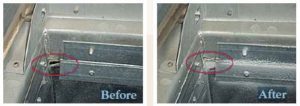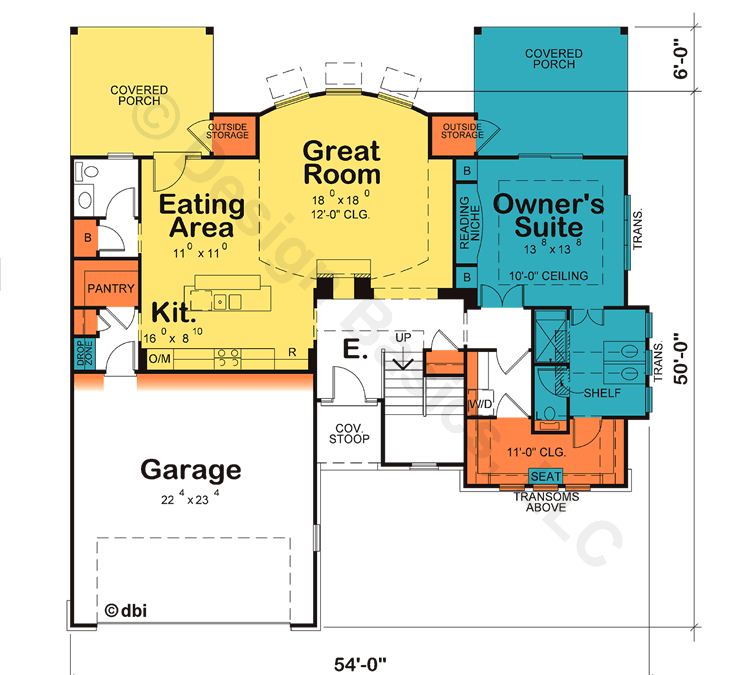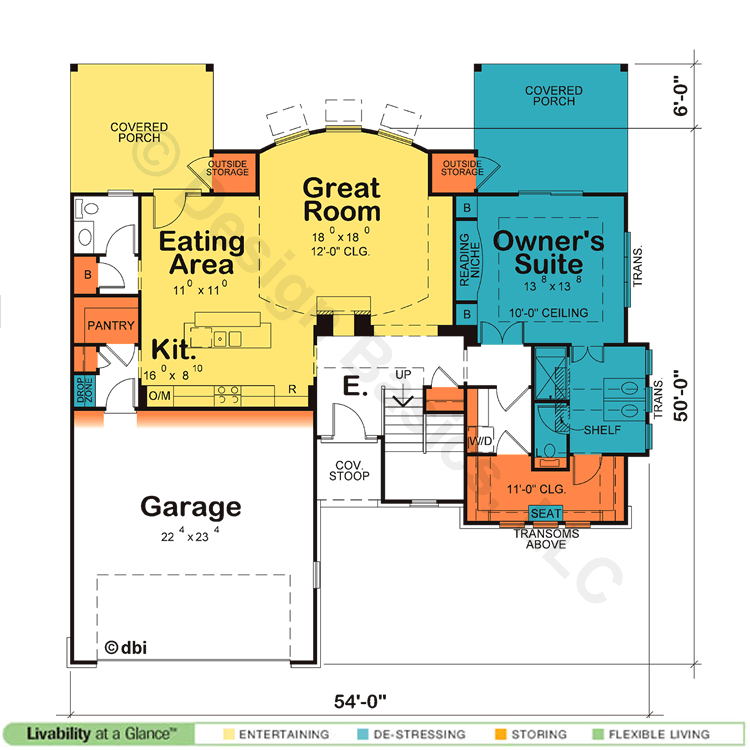by Michele Weaver | Nov 8, 2017 | HER Home, Problems Solved
By focusing on energy efficiency, you can reduce greenhouse gas emissions (carbon dioxide, sulfer dioxide, and nitrogen oxides) by thousands of pounds per year. Great strides have been made in insulating walls, window quality, and furnace efficiency. But, according to the U.S. Department of Energy, air duct leakage is the #1 home energy loss.
 Aeroseal® manufactures an aerosol sealant that is sprayed into your ductwork to seal leaks from the inside. Safe and nontoxic, Aeroseal has actually been shown to enhance indoor air quality. Improved delivery of conditioned air means rooms that were hard to keep warm in the winter/cool in the summer are usually more comfortable while saving you money every month on your utility bills.
Aeroseal® manufactures an aerosol sealant that is sprayed into your ductwork to seal leaks from the inside. Safe and nontoxic, Aeroseal has actually been shown to enhance indoor air quality. Improved delivery of conditioned air means rooms that were hard to keep warm in the winter/cool in the summer are usually more comfortable while saving you money every month on your utility bills.
According to Aeroseal, “On average, 30 cents of every $1 you spend on heating and cooling your home or building disappears into thin air due to duct leaks.” With more of the air you paid to heat or cool reaching the registers, you may find yourself actually lowering the thermostat.
Another benefit can be noise reduction—with the furnace and/or air conditioner running less.
Learn more about Aeroseal products.
by Michele Weaver | Aug 18, 2017 | HER Home, Problems Solved
 While more and more of our digital life is becoming wireless, wireless solutions continue to be plagued by signal strength issues and download/upload speeds. In a room over a garage finished off as a home office space, a Design Basics customer recently reported intermittent signal losses and average download speeds of only 2-4 Mbps, compared with 50 Mbps throughout the rest of the home. The solution was wiring an Ethernet connection in that space – not an easy task after the home was built.
While more and more of our digital life is becoming wireless, wireless solutions continue to be plagued by signal strength issues and download/upload speeds. In a room over a garage finished off as a home office space, a Design Basics customer recently reported intermittent signal losses and average download speeds of only 2-4 Mbps, compared with 50 Mbps throughout the rest of the home. The solution was wiring an Ethernet connection in that space – not an easy task after the home was built.
Whether it’s HD video or the latest multi-player online games, for stationary applications, hardwired Ethernet is preferable to wireless connectivity for dependable performance and to get the most from your entertainment and computer systems. Ethernet provides another important advantage, low voltage power for your device can be run over the same Ethernet cable so you can eliminate additional electrical wiring and those bulky AC transformers.
For more helpful building tips, visit our Resource Center.

by Michele Weaver | Jul 11, 2017 | Great Design, Problems Solved
 In May, my son graduated Magna Cum Laude with a degree in marketing. As a high school senior, he set a national sales record for one of North America’s largest electronics retailers. The kid is smart. But when it came time to purchase a new car last weekend, he and his fiancée (who also has a business degree) were novices. Not that they hadn’t researched vehicles online. Not that they didn’t know what was important to them in a new vehicle. Not that they didn’t know what they could afford. It’s just that neither had ever purchased a brand-new vehicle. Rebates or lower APR? Extended warranty? Rustproofing? “Sport” edition? Price negotiation? Then there was the high-pressure sales tactics…
In May, my son graduated Magna Cum Laude with a degree in marketing. As a high school senior, he set a national sales record for one of North America’s largest electronics retailers. The kid is smart. But when it came time to purchase a new car last weekend, he and his fiancée (who also has a business degree) were novices. Not that they hadn’t researched vehicles online. Not that they didn’t know what was important to them in a new vehicle. Not that they didn’t know what they could afford. It’s just that neither had ever purchased a brand-new vehicle. Rebates or lower APR? Extended warranty? Rustproofing? “Sport” edition? Price negotiation? Then there was the high-pressure sales tactics…
Similarly, how many of your prospective home buyers took classes in home design, home building, or buying a new home when they were college students? With such a monumental decision, how do you help buyers choose you?
Listen…and build rapport. The first salesperson my son met couldn’t wait to demonstrate the vehicle. He quickly identifed the model he thought would most interest this young couple, then spent quite a bit of time showing them the many features. This was followed by the customary test-drive during which the sales person spent most of his time texting.
I’ve met new home sales pros who likewise want to get right to touring visitors through their model home. Most are superb at highlighting the hot-button amenities. But people want to buy from someone they like, someone who cares about them, someone they can trust, and that takes time getting to know them and listening to what they want.
 Edu-sell. Price is always important, but selling via lowest price is both difficult and lazy. Difficult, because there are only so many corners you can cut, so many suppliers you can bully into dropping their price. Lazy, because the consumer doesn’t have to think and the salesperson doesn’t have to deal with educating the customer, quality, or other “intangibles.”
Edu-sell. Price is always important, but selling via lowest price is both difficult and lazy. Difficult, because there are only so many corners you can cut, so many suppliers you can bully into dropping their price. Lazy, because the consumer doesn’t have to think and the salesperson doesn’t have to deal with educating the customer, quality, or other “intangibles.”
The salesman who won my son’s business quickly established rapport over their mutual admiration for Apple products. He segued that into introducing Apple Car Play, found in some of their vehicles. He took the time to discuss all-wheel drive options, various trim levels/options, and what was included, such as explaining the pros and cons of leather seats.
New home buyers don’t know what they don’t know. Your ability to modify standard designs; delightful new amenities prospects didn’t even know existed; product upgrades ideally matched to their priorities; these are all ways to empower buyers to make the best decisions, within the budget they have established for themselves, making you their advisor who has their best interests at heart.
Make the process easy, fun, and (relatively) stress-free. For my son and his fiancée, their salesman turned car shopping into a process of discovery. The vehicle they ultimately purchased was not even on their radar screen initially. From the big touch screen display with back-up camera, to the “Vehicle Protection Package,” to sorting through the business office/finance options, this dealership understood how to respect their customers.
Your homes are designed. Your home building system was designed. Your customers’ new home purchase experience should be designed, too. Looking at the purchase experience through the eyes of the customer is the place to start, rather than what’s efficient for you. Concentrate especially on the areas which can be stressful (e.g., finalizing the design, product selections, and the purchase agreement). Above all else, focus on clear communication, because ambiguity is no one’s friend!
Author: Paul Foresman, VP Business Development, Design Basics, LLC

by Design Basics | Jun 8, 2016 | Great Design
How do you get people, especially the media, to notice what you’re doing? The following process isn’t rocket science and isn’t as high-tech as some, but it has worked:
You’ve got a story to tell.
There’s a reason why you do that…designed it that way…or offer that amenity. It’s your story and to communicate it effectively it needs to be simple and conveyed with passion – elements that also your story memorable. Hosting a charity fundraiser in conjunction with the grand opening of your new model home? There’s a reason why you chose to support that charity. Plus, charitable organizations generally do a very good job of getting the word out to their constituents. There’s nothing wrong with doing good and getting credit for it! Looking to attract the attention of your local news media? Your story must be newsworthy and will help get people talking.
Who has the attention of prospective home buyers?
The media selects stories based on their agendas, not yours. And, media outlets are interested in stories that appeal to a large percentage of their audience. Fortunately, housing is a topic that affects just about everyone. For example, let’s say you build stronger/safer homes–that’s your story. Did severe storms damage houses in your area last night? Then this morning is the perfect time to contact local news media about how new homes can be built to better able to withstand Mother Nature’s fury. It’s timely content for newspapers and local TV newscasts…and insurance agents, mortgage lenders, Realtors®…
You’re the expert.
As an area housing expert, reporters will often contact you as housing related issues come up. Whether it’s home technology, healthier homes, aging-in-place, or green building, your focus should be your market leadership and credibility. Be sure to have proof or evidence handy if you are making a claim. To back up the severe weather example claim, point out the added protection of hail-impact rated shingles and fiber cement siding that were used in your construction.
You’re the innovator.
(Note: This is superior to “being the expert” because the innovator is typically also perceived as the expert in that aspect of housing.) What are you bringing to the local housing market that other builders aren’t doing? Emphasize how this innovation is relevant/meaningful/appealing to your identified audience and approach it from that perspective. Your focus needs to be differentiation—your uniqueness – such as building energy efficient, environmentally responsible homes. From saving money on utilities to keeping jobsite waste out of landfills through recycling to the “bragging rights” of owning a green home, you have several appealing stories. But again, focus on the unique. There may be a lot of local Energy Star builders, but if you are the first builder in your market to guarantee your home buyer’s utility bills, now there’s a great story!
Create press releases and follow up after sending them out.
If you’re not a writer, that’s okay. Hire an agency, a freelance writer, or contact a local community college and have them identify a bright student who’s looking for some experience. Try to keep your press release to one page in length. Have it available as a Microsoft Word document as well as printed copies. Include photographs and/or video footage to illustrate your point(s). The more interesting its headline, the more likely your release will be noticed and remembered when you phone to follow up. Events, unveilings, even a little controversy can spice up a headline.
What’s your story? Visit our Home Design Articles page for some ideas and inspiration.

by Design Basics | May 9, 2016 | Great Design
Of all the ways builders try to differentiate themselves from the competition, one of the most underutilized is being known for building healthier homes. Having a home free from outside noise betters our chances for rest, promotes concentration, reduces irritability, and has been shown to have a positive impact on our mental health. Properly designed lighting lowers body stress and eyestrain, improving learning and behavior. And, according to the American College of Allergy, Asthma & Immunology, half of all illnesses are either caused by, or aggravated by, polluted indoor air.
Do Not Disturb
Few things in life are as important to our physical and mental health as a good night’s sleep. According to a study published in the Journal of Occupational and Environmental medicine, environmental noise can impact the mental health of children. In the same study, researchers found that environmental noise significantly impacted students’ academic performance, their social behavior, and how easily they became distracted.
Since most sounds travel through the air, tight-fitting doors and windows along with advanced air sealing measures, much of the unwanted clatter that goes on outside cannot be heard inside the home. Soft-closing cabinet doors, along with quiet appliances, garbage disposals, bath fans, and furnaces reduce indoor noise even further. Eleven- or twelve-foot high walls in a great room, as opposed to a full two-story ceiling, reduces annoying echoes.
Suggest a flex space in the home purposed as the “wellness area” – this could be for prayer/meditation or reading for de-stressing. Alternately, this might be an exercise area. Rapidly developing technology coupled with the Affordable Care Act mean elderly home buyers and individuals with ailments such as diabetes need a place for home health monitoring.
Lights Up
Windows not only connect us to the world around us, they’re very important for health. Yet, most people underestimate the importance of natural light. According to Dr. John Ott, the UV rays in natural light actually help our bodies absorb calcium, reduce cholesterol, and lower blood pressure. Careful placement and sizing of windows can usher in more daylight. Rooms with windows on two sides amplify sunlight, an especially important consideration for north-facing rooms. Skylights, due to their angled orientation to the sun, allow three times as much sunlight into the home as a similar-size window in a vertical wall.
Glass block or awning windows placed above the backsplash can bring more daylight into kitchens. Open design concepts, transom windows between living spaces with walls, and even lighter interior colors all increase light levels in the home, known to reduce eyestrain, headaches, and fatigue. Numerous studies have shown that students learn faster, are happier, and experience fewer absences in environments with higher levels of daylight. Bathrooms, with limited opportunity for windows, can be designed to take maximum advantage of mirrors that reflect the available natural light.
Equally important is increasing levels of artificial lighting in the home. Due to the yellowing and hardening of our eyes’ lenses as we age, 60-year old individuals only “see” about half of the light levels of their 20-year old counterparts. The number of lighting fixtures, their placement, and light bulb “brightness” all come into play.
Achoo!
With four of every ten households having one or more members suffering from asthma or allergies, building healthier homes may be just the prescription Americans need to breathe a little easier.
The Centers for Disease Control reports that approximately 26 million Americans suffer from asthma and 50 million more from allergies. Building a very ‘tight,’ energy efficient home helps control the intrusion of most allergens, mold, bacteria, and viruses from entering the home, but compounds the potential for some indoor air quality problems as airborne pollutants from household chemicals and cooking can become trapped inside the home. It is critical that fresh air is brought into the home at a controlled rate, first passing through advanced filtration/purification equipment that traps and destroys airborne pollutants before being circulated through the house. Potentially stale or polluted air is also exhausted from the home—expelling odors and airborne germs.
The average 1,500 sq. ft. home generates 40 pounds of dust per year and each ounce of dust can contain thousands of dust mites. Dust mites are particularly problematic for allergy and asthma sufferers. Carpeting is a haven for dust mites, compared to easy-to-clean hard surface flooring. Dust mites thrive in warm, moist environments, but they die when humidity drops below 40%. Be sure to explain that the use of air conditioning as well as bath and kitchen exhaust fans is important in the battle against dust mites.
That “new home smell” is actually related to unhealthy off-gassing and volatile organic compounds (VOCs). Low- or zero-VOC products selected for the construction of the home is another wise choice. Finally, radon is the second leading cause of lung cancer, accounting for over 20,000 deaths annually according the U.S. Surgeon General. While radon-resistant new construction is required in some areas, homes being built in U.S. EPA Radon Zones 1 and 2 are strong candidates for a radon mitigation system.
It All Begins With a Plan
A first step is to find a home plan that meets your needs and can easily incorporate these healthier home ideas. Finding a plan with high levels of natural light is a great place to start!

The Gainsville (#6651) – Features windows on multiple sides of most rooms.
The Sunset Gable (#42231V) – Skylights provide welcome sunlight in the family room while maintaining a wall for furniture and artwork.
The Pinnacle (#3284) – Note that windows in kitchen between backsplash and upper cabinets balance the need for privacy and natural light.
The Draper (#50031) – An owner’s suite bath with abundant natural light at the vanities (see plan at right).
Search for a plan.
 Aeroseal® manufactures an aerosol sealant that is sprayed into your ductwork to seal leaks from the inside. Safe and nontoxic, Aeroseal has actually been shown to enhance indoor air quality. Improved delivery of conditioned air means rooms that were hard to keep warm in the winter/cool in the summer are usually more comfortable while saving you money every month on your utility bills.
Aeroseal® manufactures an aerosol sealant that is sprayed into your ductwork to seal leaks from the inside. Safe and nontoxic, Aeroseal has actually been shown to enhance indoor air quality. Improved delivery of conditioned air means rooms that were hard to keep warm in the winter/cool in the summer are usually more comfortable while saving you money every month on your utility bills.
 While more and more of our digital life is becoming wireless, wireless solutions continue to be plagued by signal strength issues and download/upload speeds. In a room over a garage finished off as a home office space, a Design Basics customer recently reported intermittent signal losses and average download speeds of only 2-4 Mbps, compared with 50 Mbps throughout the rest of the home. The solution was wiring an Ethernet connection in that space – not an easy task after the home was built.
While more and more of our digital life is becoming wireless, wireless solutions continue to be plagued by signal strength issues and download/upload speeds. In a room over a garage finished off as a home office space, a Design Basics customer recently reported intermittent signal losses and average download speeds of only 2-4 Mbps, compared with 50 Mbps throughout the rest of the home. The solution was wiring an Ethernet connection in that space – not an easy task after the home was built.
 In May, my son graduated Magna Cum Laude with a degree in marketing. As a high school senior, he set a national sales record for one of North America’s largest electronics retailers. The kid is smart. But when it came time to purchase a new car last weekend, he and his fiancée (who also has a business degree) were novices. Not that they hadn’t researched vehicles online. Not that they didn’t know what was important to them in a new vehicle. Not that they didn’t know what they could afford. It’s just that neither had ever purchased a brand-new vehicle. Rebates or lower APR? Extended warranty? Rustproofing? “Sport” edition? Price negotiation? Then there was the high-pressure sales tactics…
In May, my son graduated Magna Cum Laude with a degree in marketing. As a high school senior, he set a national sales record for one of North America’s largest electronics retailers. The kid is smart. But when it came time to purchase a new car last weekend, he and his fiancée (who also has a business degree) were novices. Not that they hadn’t researched vehicles online. Not that they didn’t know what was important to them in a new vehicle. Not that they didn’t know what they could afford. It’s just that neither had ever purchased a brand-new vehicle. Rebates or lower APR? Extended warranty? Rustproofing? “Sport” edition? Price negotiation? Then there was the high-pressure sales tactics… Edu-sell. Price is always important, but selling via lowest price is both difficult and lazy. Difficult, because there are only so many corners you can cut, so many suppliers you can bully into dropping their price. Lazy, because the consumer doesn’t have to think and the salesperson doesn’t have to deal with educating the customer, quality, or other “intangibles.”
Edu-sell. Price is always important, but selling via lowest price is both difficult and lazy. Difficult, because there are only so many corners you can cut, so many suppliers you can bully into dropping their price. Lazy, because the consumer doesn’t have to think and the salesperson doesn’t have to deal with educating the customer, quality, or other “intangibles.”


